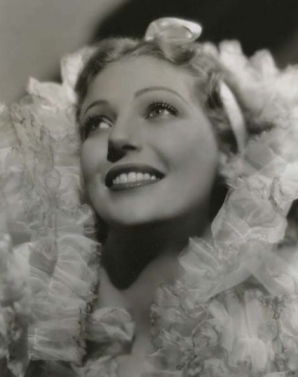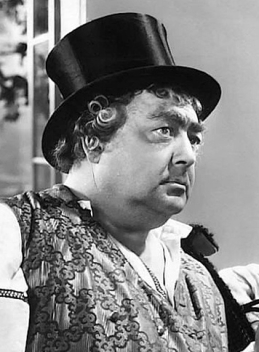 Here’s one of the great things about living in New York City: you can see an obscure, black & white movie in 35 mm at 4 o’clock on a Friday afternoon, and the theater is packed with people. Sure, many of those people are abjectly odd, plastic bag-crinkling Old Movie Weirdos, but you can’t beat a big crowd! (Even if you would like to, with a blunt instrument).
Here’s one of the great things about living in New York City: you can see an obscure, black & white movie in 35 mm at 4 o’clock on a Friday afternoon, and the theater is packed with people. Sure, many of those people are abjectly odd, plastic bag-crinkling Old Movie Weirdos, but you can’t beat a big crowd! (Even if you would like to, with a blunt instrument).
This afternoon, the Museum of Modern Art debuted a new 35mm print of Erik Charell’s CARAVAN (1934), a delightful musical farce starring 21-year-old Loretta Young as a rebellious Hungarian countess about to inherit a fortune, Phillips Holmes as the military officer nominated to be her husband, and Charles Boyer – in his first leading role in an American film – as the gypsy fiddler who gets his bow between them.
Released by the Fox Film Corporation in September of 1934, eight months before the merger with Twentieth Century Pictures that rescued the studio from bankruptcy, CARAVAN has been, according to MoMA, “virtually unseen for more than 80 years.” The 35 mm print screened today as part of the 11th annual MoMA International Festival of Film Preservation was struck from the Museum’s collection of nitrate film holdings from Fox, and it looked and sounded flawless.
 Based on an original story by Hungarian journalist Melchior Lengyel, who would go on to pen the stories upon which NINOTCHKA (1939) and TO BE OR NOT TO BE (1942) were based, CARAVAN was a critical and box office failure in its initial U.S. release, effectively ending Charell’s film career. That’s unfortunate, because the film is beautifully staged, with an over-the-top visual style that evokes Busby Berkeley and unusually fluid camerawork for the early days of sound filmmaking.
Based on an original story by Hungarian journalist Melchior Lengyel, who would go on to pen the stories upon which NINOTCHKA (1939) and TO BE OR NOT TO BE (1942) were based, CARAVAN was a critical and box office failure in its initial U.S. release, effectively ending Charell’s film career. That’s unfortunate, because the film is beautifully staged, with an over-the-top visual style that evokes Busby Berkeley and unusually fluid camerawork for the early days of sound filmmaking.
Born Erich Lowenburg in what is now the largest city in western Poland, Charell got his start on the German stage, directing revues and operettas at the Grosses Schauspielhaus (Great Theater) in Berlin. He achieved celluloid success for Weimar Era studio UFA with CONGRESS DANCES, a 1932 musical starring Conrad Veidt and Lilian Harvey (also seen in Rowland V. Lee’s I AM SUZANNE (1933), another oddity resurrected by MoMA for this festival).
 Not surprisingly, CARAVAN feels reminiscent of the operatic rom coms German-born Ernst Lubitsch was churning out at the time for Paramount, most starring French actor/singer Maurice Chevalier. While Boyer lacks the rakish joie de vivre of Chevalier, he is exceedingly charming as Lazi, an itinerant musician impulsively proposed to by Wilma, a Hungarian princess forced to marry by her uncle (C. Aubrey Smith). Unlike Lubitsch leading lady Jeanette MacDonald, Loretta Young doesn’t sing, but what she lacks in song she makes up for in sexiness. Young was one of the most natural actresses of the Pre-Code Era, and her subtle sexuality practically leaps off the screen when she meets the handsome lieutenant who, unbeknownst to her, is her intended bridegroom. While CARAVAN was released a few months after enforcement of the Motion Picture Production Code censorship regulations began, it still has the spirit of a Pre-Code film, with characters who seem to actually engage in, and enjoy, sexual activity.
Not surprisingly, CARAVAN feels reminiscent of the operatic rom coms German-born Ernst Lubitsch was churning out at the time for Paramount, most starring French actor/singer Maurice Chevalier. While Boyer lacks the rakish joie de vivre of Chevalier, he is exceedingly charming as Lazi, an itinerant musician impulsively proposed to by Wilma, a Hungarian princess forced to marry by her uncle (C. Aubrey Smith). Unlike Lubitsch leading lady Jeanette MacDonald, Loretta Young doesn’t sing, but what she lacks in song she makes up for in sexiness. Young was one of the most natural actresses of the Pre-Code Era, and her subtle sexuality practically leaps off the screen when she meets the handsome lieutenant who, unbeknownst to her, is her intended bridegroom. While CARAVAN was released a few months after enforcement of the Motion Picture Production Code censorship regulations began, it still has the spirit of a Pre-Code film, with characters who seem to actually engage in, and enjoy, sexual activity.
 CARAVAN’s story feels familiar, with tired tropes like the preferred suitor, rich/poor romance, and mistaken identity, but the enterprise is elevated by inventive staging and an all-star cast of supporting players. On loan from MGM, Louise Fazenda is a hoot as Young’s governess, transforming from uptight schoolmarm to lighthearted flirt when the gypsies overtake the castle in musical merriment. Frog-voiced Eugene Palette is money in the bank as the pragmatically larcenous gypsy king. Charley Grapewin (Uncle Henry from THE WIZARD OF OZ) shows up as a crooked lawyer, silent comic Billy Bevan is a cop, and a young Noah Beery plays an innkeeper. And perhaps best of all is Jean Parker as the loyal gypsy girl who loves Boyer, and must connive to win him from the fickle countess.
CARAVAN’s story feels familiar, with tired tropes like the preferred suitor, rich/poor romance, and mistaken identity, but the enterprise is elevated by inventive staging and an all-star cast of supporting players. On loan from MGM, Louise Fazenda is a hoot as Young’s governess, transforming from uptight schoolmarm to lighthearted flirt when the gypsies overtake the castle in musical merriment. Frog-voiced Eugene Palette is money in the bank as the pragmatically larcenous gypsy king. Charley Grapewin (Uncle Henry from THE WIZARD OF OZ) shows up as a crooked lawyer, silent comic Billy Bevan is a cop, and a young Noah Beery plays an innkeeper. And perhaps best of all is Jean Parker as the loyal gypsy girl who loves Boyer, and must connive to win him from the fickle countess.
The songs, by German-born composer Werner Richard Heymann and Tin Pan Alley lyricist Gus Kahn, are infectiously catchy and used somewhat sparingly, which was a nice surprise. No explanation is offered as to why a gypsy with a French accent is singing about the decidedly American concept of “Hot Cha Cha” in Hungary, which is part of the film’s absurdly comic appeal.
Like Lubitsch’s Paramount musicals, Charell shot a simultaneous French version with Boyer reprising his role, supported by Annabella (the future Mrs. Tyrone Power) as Wilma, Pierre Brasseur (later to star in Marcel Carne’s PORT OF SHADOWS and CHILDREN OF PARADISE) as the handsome lieutenant, Conchita Montenegro (LOLA MONTES) as the gypsy girl, and the ubiquitous Luis Alberni as the gypsy king. No word on the status of that version, but it would be fun to compare the two in a DVD or Blu-ray release.
I’d love to tell you that you can watch CARAVAN somewhere, but you can’t. However, if you’re anywhere near New York City on Sunday, November 10, MoMA is playing the film one more time, as the Preservation Festival draws to a close. If you make it to the screening, and you have something you need to carry home, I guarantee you there will be plenty of crinkly plastic bags in the house. I’m sure one of the Old Movie Weirdos at MoMA will lend you one, because they’re a pretty charming bunch.









would have loved to have been there! I adore Loretta Young and can see her sweeping onto my tv screen in those elegant gowns to introduce the play we were about to be entertained by…she was a true star in my young eyes…why doesn’t TVLAND go back to the classics that gave them their game instead of the dross and yuck we are being subjected to now? Give me the true talent everytime…still can’t praise TCM enough…popcorn a diet coke and my beloved Cary Grant in My Favorite Wife had me howling with laughter and falling in love with the talents of yesterday…lucky you to have such a theater right there!
Sandi
That was an excellent article. I would love to see the movie! I wonder if my grandmother saw it – Charles Boyer was one of her favorites, maybe this movie started it. I’m not sure Louise Fazenda was with MGM though, I thought she was with Warner Bros. She was married to Hal Wallis at any rate and did a lot of Warner films.
Great article! Sound like a great movie. You’re scaring me though. I’m wondering if a plastic bag and a few more years are the only things separating me from an old movie weirdo!
*Applause* for your articulate appreciation of older classic films, e.g. Caravan. The charming, handsome Charles Boyer was under-appreciated for some time, but anyone who can catch enough of his films sees quickly what a nuanced and versatile actor he was. He’s one of my favourites. I hope you’ll write more on Boyer’s films. Have you seen Le Bonheur which he did first on stage and then on film.
As a footnote, Boyer had learned to play the violin as a boy, which added to his bowing on screen.